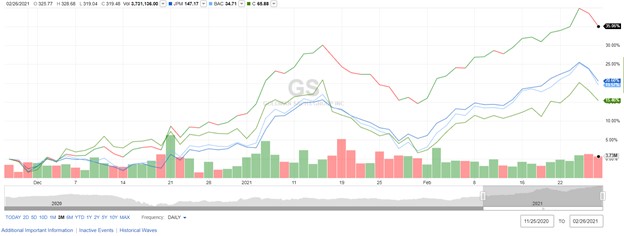The prospect of rising interest rates has propelled bank stocks to all-high highs. Citigroup (C), JPMorgan (JPM), Bank of America (BAC), and Goldman Sachs (GS) have appreciated double digits over the past three months, breaking out to all-time highs. Rising interest rates combined with the highly disruptive COVID-19 backdrop abating has served as the foundation for this move higher. The big banks responded and evolved in the face of COVID-19 to the real possibility of widespread loan defaults, liquidity issues, ballooning credit card debt, and stressed mortgages. To exacerbate these COVID-19 impacts, interest rates, Federal Reserve actions, yield curve inversion, and liquidity heavily weighed on the sector.
Along with this turn higher, balance sheets have become even stronger now that share buybacks have been halted and dividend payouts were arrested. Large capital reserves have already been put aside for anticipated financial challenges. The big banks have demonstrated their ability to evolve in the face of COVID-19 and present compelling value. Now with the prospect of rising rates, this may serve as a long-term tailwind for banks to appreciate higher.
COVID-19 and Financial Crisis – Lessons Learned
The big banks are far stronger and more prepared than they were during the 2008 Financial Crisis. Lessons learned from the Financial Crisis yielded rigorous annual stress tests that forced banks to maintain a slew of fiscal discipline measures. With the Federal Reserve working in-hand with the banks, a financial bridge to those businesses and consumers negatively impacted by COVID-19 as a stop-gap measure has been afforded. As this pandemic subsides and economic activity rebounds the banks' present value. Add in the prospect of higher rates, and the banks are set-up for long-term appreciation. Their strong cash positions and healthy balance sheets are allowing dividends to continue as the economy transitions through the damage of the pandemic. Continue reading "The Prospect Of Higher Rates Boost Big Banks"

